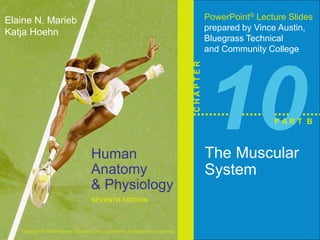More Related Content
Similar to Muscular System Chapter 10 Summary
Similar to Muscular System Chapter 10 Summary (20)
Muscular System Chapter 10 Summary
- 1. Human
Anatomy
& Physiology
SEVENTH EDITION
Elaine N. Marieb
Katja Hoehn
Copyright © 2006 Pearson Education, Inc., publishing as Benjamin Cummings
PowerPoint® Lecture Slides
prepared by Vince Austin,
Bluegrass Technical
and Community College
C H A P T E R
10
The Muscular
System
P A R T B
- 2. Muscles of the Anterior Neck and Throat:
Suprahyoid
Four deep throat muscles
Form the floor of the oral cavity
Anchor the tongue
Elevate the hyoid
Move the larynx superiorly during swallowing
Copyright © 2006 Pearson Education, Inc., publishing as Benjamin Cummings
- 3. Muscles of the Anterior Neck and Throat:
Suprahyoid
Copyright © 2006 Pearson Education, Inc., publishing as Benjamin Cummings
Figure 10.8a
- 4. Muscles of the Anterior Neck and Throat:
Infrahyoid
Straplike muscles that depress the hyoid and larynx
during swallowing and speaking
Copyright © 2006 Pearson Education, Inc., publishing as Benjamin Cummings
- 5. Muscles of the Anterior Neck and Throat:
Infrahyoid
Copyright © 2006 Pearson Education, Inc., publishing as Benjamin Cummings
Figure 10.8b
- 6. Muscles of the Neck: Head Movements
Major head flexor is the sternocleidomastoid
Synergists to head flexion are the suprahyoid and
infrahyoid
Lateral head movements are accomplished by the
sternocleidomastoid and scalene muscles
Head extension is accomplished by the deep
splenius muscles and aided by the superficial
trapezius
Copyright © 2006 Pearson Education, Inc., publishing as Benjamin Cummings
- 7. Muscles of the Neck: Head Movements
Copyright © 2006 Pearson Education, Inc., publishing as Benjamin Cummings
Figure 10.9a
- 8. Muscles of the Neck: Head Movements
Copyright © 2006 Pearson Education, Inc., publishing as Benjamin Cummings
Figure 10.9b
- 9. Trunk Movements: Deep Back Muscles
The prime mover of back extension is the erector
spinae
Erector spinae, or sacrospinalis, muscles consist of
three columns on each side of the vertebrae –
iliocostalis, longissimus, and spinalis
Lateral bending of the back is accomplished by
unilateral contraction of these muscles
Other deep back extensors include the semispinalis
muscles and the quadratus lumborum
Copyright © 2006 Pearson Education, Inc., publishing as Benjamin Cummings
- 10. Trunk Movements: Deep Back Muscles
Copyright © 2006 Pearson Education, Inc., publishing as Benjamin Cummings
Figure 10.9d
- 11. Trunk Movements: Short Muscles
Four short muscles extend from one vertebra to
another
These muscles are synergists in extension and
rotation of the spine
Copyright © 2006 Pearson Education, Inc., publishing as Benjamin Cummings Figure 10.9c
- 12. Muscles of Respiration: External Intercostals
The primary function of
deep thoracic muscles is
to promote movement
for breathing
External intercostals –
more superficial layer
that lifts the rib cage and
increases thoracic
volume to allow
inspiration
Copyright © 2006 Pearson Education, Inc., publishing as Benjamin Cummings
Figure 10.10a
- 13. Muscles of Respiration: Internal Intercostals
Internal intercostals –
deeper layer that aids in
forced expiration
Diaphragm – most
important muscle in
inspiration
Copyright © 2006 Pearson Education, Inc., publishing as Benjamin Cummings
Figure 10.10a
- 14. Muscles of Respiration: The Diaphragm
Copyright © 2006 Pearson Education, Inc., publishing as Benjamin Cummings
Figure 10.10b
- 15. Muscles of the Abdominal Wall
The abdominal wall is composed of four paired
muscles (internal and external obliques,
transversus abdominis, and rectus abdominis), their
fasciae, and their aponeuroses
Fascicles of these muscles run at right and oblique
angles to one another, giving the abdominal wall
added strength
Copyright © 2006 Pearson Education, Inc., publishing as Benjamin Cummings
- 16. Muscles of the Abdominal Wall
In addition to forming the abdominal wall, these
muscles:
Are involved with lateral flexion and rotation of
the trunk
Help promote urination, defecation, childbirth,
vomiting, coughing, and screaming
Copyright © 2006 Pearson Education, Inc., publishing as Benjamin Cummings
- 17. Muscles of the Abdominal Wall
Copyright © 2006 Pearson Education, Inc., publishing as Benjamin Cummings
Figure 10.11a
- 18. Muscles of the Abdominal Wall
Copyright © 2006 Pearson Education, Inc., publishing as Benjamin Cummings
Figure 10.11b
- 19. Muscles of the Abdominal Wall
Copyright © 2006 Pearson Education, Inc., publishing as Benjamin Cummings
Figure 10.11c
- 20. Muscles of the Pelvic Floor (Pelvic
Diaphragm)
The pelvic diaphragm is composed of two paired
muscles – levator ani and coccygeus
These muscles:
Close the inferior outlet of the pelvis
Support the pelvic floor
Elevate the pelvic floor to help release feces
Resist increased intra-abdominal pressure
Copyright © 2006 Pearson Education, Inc., publishing as Benjamin Cummings
- 21. Muscles of the Pelvic Floor: Pelvic Diaphragm
Copyright © 2006 Pearson Education, Inc., publishing as Benjamin Cummings
Figure 10.12a
- 22. Muscles Inferior to the Pelvic Floor
Two sphincter muscles allow voluntary control of
urination (sphincter urethrae) and defecation
(external anal sphincter)
The ischiocavernosus and bulbospongiosus assist
in erection of the penis and clitoris
Copyright © 2006 Pearson Education, Inc., publishing as Benjamin Cummings
- 23. Muscles of the Pelvic Floor
Copyright © 2006 Pearson Education, Inc., publishing as Benjamin Cummings
Figure 10.12b
- 24. Muscles of the Pelvic Floor
Copyright © 2006 Pearson Education, Inc., publishing as Benjamin Cummings
Figure 10.12c
- 25. Extrinsic Shoulder Muscles
Muscles of the thorax
Anterior: pectoralis major, pectoralis minor,
serratus anterior, and subclavius
Posterior: latissimus dorsi, trapezius muscles,
levator scapulae, and rhomboids
These muscles are involved with the movements of
the scapula including elevation, depression,
rotation, and lateral and medial movements
Prime movers of shoulder elevation are the
trapezius and levator scapulae
Copyright © 2006 Pearson Education, Inc., publishing as Benjamin Cummings
